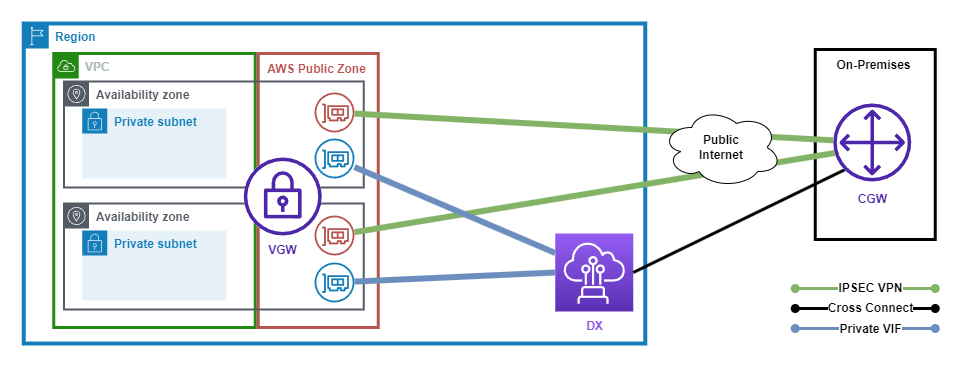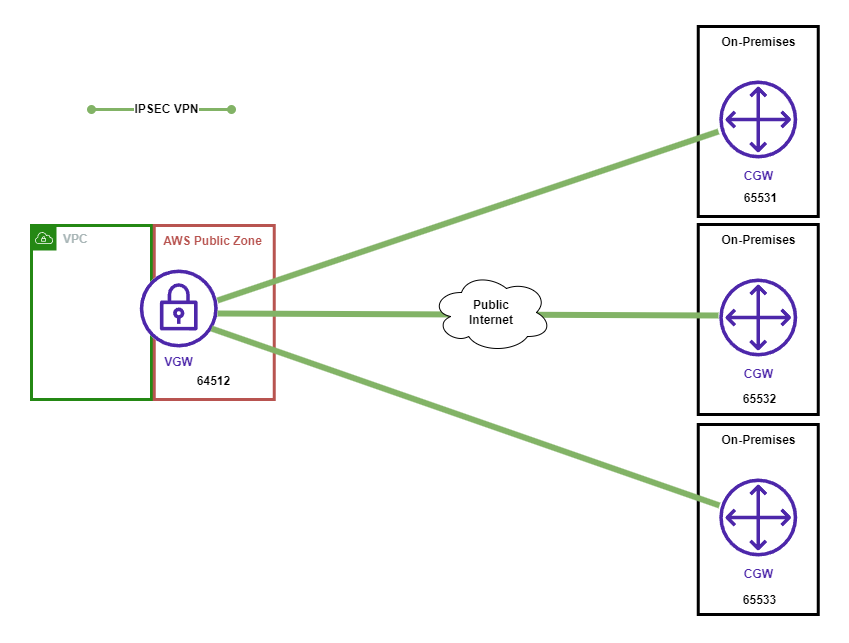Cloud Notes: AWS VGW
published: 28th of December 2023
Intro
Virtual Private Gateways (VGWs) are an AWS manged VPN concentrator service which allow non-AWS and other AWS account networks to connect to a VPC via IPSEC VPN or Direct Connect.
VGW Architecture
The following diagram shows a typical VGW architecture.

The following points describe the above diagram.
- The VGW is deployed in the AWS public zone across 2x AZs for HA.
- A customer gateway (CGW) is deployed in the customers network and is configured to connect with the VGW public IP addresses via IPSEC.
- A customer gateway (CGW) object is created in AWS to represent the CGW in the customers network.
- For each CGW object, the VGW has 2x public IP addresses, one in each AZ which are used for VPN connections.
- A direct connect (DX) is configured to connect to the VGW via private VIFs.
- The VGW has 2x private IP addresses, one in each AZ which are used for DX connections.
- The VGW is attaced to a VPC, subnet routing is directed to the VGW via the subnets route-table.
VGW Considerations
The following considerations apply to VGWs.
- A VGW can be attached to a maximum of 1 VPC at a time.
- If a VGW is migrated from one VPC to another, the connections are maintained.
- IPSEC VPN has a maximum throughput of 1.25Gbps.
- Each VGW has a a maximum total throughput of 1.25Gbps
- VGWs can use either static routing or Dynamic routing via BGP.
- BGP uses a Private Autonomous System Number (ASN) and by default is assigned 64512.
- VGWs can only connect to a DX connection in the same region.
VPN CloudHub
VPN Cloud Hub is a method of connecting multiple remote networks to a Virtual Private Gateway (VGW) in a hub and spoke topology.
The following diagram shows a typical VPN CloudHub architecture.

The following points describe the above diagram.
- The VGW is acting as the HUB.
- Each on-premises network are spokes.
- Each spoke is connected to the VGW via IPSEC VPN.
- The spokes communicate to each other via the Hub.
- Each site is configured with a unique BGP ASN.
- BGP is used to exchange routes between the VGW and the CGWs.
Links
https://learn.cantrill.io/courses/1231680/lectures/31664188
https://docs.aws.amazon.com/vpn/latest/s2svpn/VPC_VPN.html
https://docs.aws.amazon.com/directconnect/latest/UserGuide/virtualgateways.html
https://docs.aws.amazon.com/vpn/latest/s2svpn/VPNRoutingTypes.html
https://docs.aws.amazon.com/vpn/latest/s2svpn/VPN_CloudHub.html